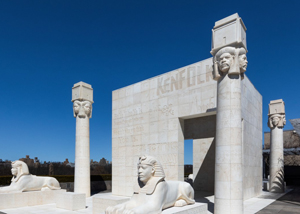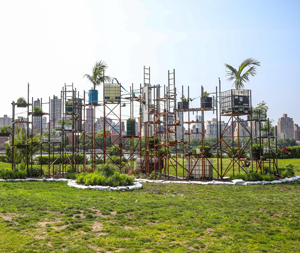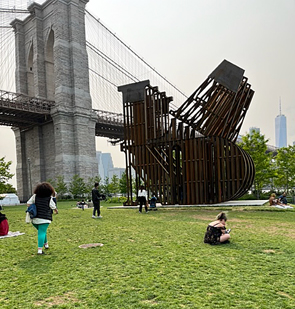From Pyramids to Parks
John Haberin New York City
Summer Sculpture 2023
Where are America's pyramids? At the Met, of course, where the Temple of Dendur has delighted scholars, tourists, and children since 1967. It came as a gift from Egypt to the United States. Now if only President Johnson could have given away a few of our monuments to the Confederacy in return.
Now it has company, just three floors away. Lauren Halsey sites her version not in the Egyptian wing, temptingly close to the main entrance, but on the roof in summer, temptingly close to a cash bar. She adapts it for this year's rooftop commission and to its ultimate destination, in South Central LA.  She also makes it a public space for others to claim as their own. She spent an extra year on it, too, to make sure that she was listening. Now if only it did not still feel like a temple or a tomb.
She also makes it a public space for others to claim as their own. She spent an extra year on it, too, to make sure that she was listening. Now if only it did not still feel like a temple or a tomb.
It also has company of different sort, throughout the city. It is only the first in New York summer sculpture. Mary Mattingly welcomes in the season and counts every minute, while Sheila Pepe adds to the greenery of Madison Square Park in fire-engine red. Pamela Rosenkranz brings still another tree to the High Line, but in pink. Nicholas Galanin in Brooklyn Bridge Park and Phyllida Barlow in City Hall Park are just two more among others heading straight for the parks. Try it yourself.
The pyramids of LA
America may seem the obvious place to compete with ancient Egypt. It has no shortage of wealth and power, and it loves monuments to the wealthy and powerful. Much of the country is still fighting the Civil War at that. Yet the closest it comes to the great pyramids may be the Vietnam War Memorial by Maya Lin, with its near pyramidal descent and reascent through the names of the dead. If you think of Egyptian stone as the world's first Brutalism in architecture, throw in the FDR memorial by Louis I. Kahn, on Roosevelt Island. Agnes Denes has had her Living Pyramid by the waterfront as well.
Not that the Temple of Dendur is a pyramid in shape or a tomb, although plenty of kids will remember being taken to see "the pyramid." I felt a strange comfort in entering so weighty a construction and so narrow a space, but not the strangeness of death. Halsey, too, takes one inside her central structure, to look for evidence of those who came before. Yet she opens things up—and not just as architect. She invited the black community to contribute, and she etches graffiti into her walls as a new form of hieroglyphics. She is affording others a mouthpiece, in a mouthful of a work of art.
This is (deep breath) the eastside of south central los angeles hieroglyph prototype architecture (I). Now that the Met has its period room for Afrofuturism, this is its deep Afropast. Halsey cites other influences as well, including George Clinton, the musician. She sticks close, though, to her true prototype, from the first century B.C.E. It amounts to one big cube, with tall columns just beyond its corners and four lions with human faces out front and back. Then she cuts away one edge of the cube except for an overhang, to open it up.
She also cuts away the top to let in the light. It has almost the entire Met roof at that, with room to circulate on all four sides as well. You can enjoy the fresh air, the monument, the views of Central Park, and a drink. I could not spot Cleopatra's Needle in the park below, but who cares? Ten years of past commissions have often been too big and too fussy—or too isolated and too small. This could be the perfect fit.
Will the community welcome it? An outsize monument could come off as oppressive, and the faces on those lions are Halsey's loved ones, not yours. Inscriptions run the opposite risk, of triviality. They include references to consumer culture, like a sign from a copy shop. Kenfolks puns on kin and a low rider there in automobile country. If, like me, you do not know what that means, you do not belong in LA.
Political tags run to platitudes and pretension, too, like Be Who You Is. (Hard to say whether street grammar makes it better or worse.) In the end, Halsey has pulled off something perfect for summer. She is thinking big and thinking open, reaching out to a museum crowd and to her roots. Critics have praised her eye on sculpture and diversity. Public spaces, though, may need something more than a temple or a tomb.
Summer time
Socrates Sculpture Park does not just welcome in the summer. With a solo slot for Mary Mattingly, "With Ebb of a Spring Tide," it ushers out a tumultuous spring. She even tracks the hours, with Water Clock—an enormous construction of tanks, pools, and planters for dozens of native species. It and the central lawn might have barely survived a devastating spring rain, but with a promise of renewal. It comes with an online plant guide, too, so that you can learn more about their variety and purposes. Just do not ask the time.
 How did the Queens waterfront get along all these years without an administrative center intruding on a precious patch of greenery? Quite well, thank you, but for now it can be tough to tell the construction site from the art. Still, Mattingly cares so much for natural growth in the face of climate change that she throw in a tent for still more plants, as her Flock House. Joiri Minaya, raised in the Dominican Republic, uses the Broadway billboard over the park's entrance with her own plea for attention to its surroundings, as The Marooned Picturesque. It reflects the neighborhood's industrial origins all the same. In abstracting away, she also makes room for fantasy.
How did the Queens waterfront get along all these years without an administrative center intruding on a precious patch of greenery? Quite well, thank you, but for now it can be tough to tell the construction site from the art. Still, Mattingly cares so much for natural growth in the face of climate change that she throw in a tent for still more plants, as her Flock House. Joiri Minaya, raised in the Dominican Republic, uses the Broadway billboard over the park's entrance with her own plea for attention to its surroundings, as The Marooned Picturesque. It reflects the neighborhood's industrial origins all the same. In abstracting away, she also makes room for fantasy.
Sheila Pepe comes to Madison Square Park in the fullness of summer and stays through the darkest days of fall. She brings a special lushness to both, as My Neighbor's Garden. The very title speaks of comfort, in familiar territory and new growth. In summer, its bright red converts the park's greenery into the colors of a December holiday. It hangs overhead, amid the tallest trees. Approaching winter, it provides a summer canopy that nature's bare branches cannot.
She also brings chaos, which is a comfort in itself. Her forest canopy weaves together parachute cord, ties, rubber bands, and shoelaces along with simple string. Her crochet caps things off now and then with its looser weave, like a summer curtain or a winter scarf. She guessed that it would reach fifteen thousand yards before she was done, and the sheer excess is fun, especially because nothing quite fits. The materials mix the sturdiness of parachute cords, which often double as utility cords, with the ephemeral, but then natural growth is ephemeral as well. Like Mattingly, she is clocking the passage of summer.
Unlike Shahzia Sikander this spring but like Cristina Iglesias on the lawn last year or Maya Lin with her own trees before that, Pepe echoes and depends on the park's existing structures and natural growth. Her streamers hang between lampposts and other poles as thick as young trees. Multicolored horizontals circle plantings at ground level, like fences to keep dogs from ruining the show. She also sticks mostly to the park's south lawn, leaving the more impressive trees of the main lawn to speak for themselves. This is site-specific sculpture that knows when to leave well enough alone.
She also depends, she wants you to know, on her female forebears. She learned crochet from her mother, and she speaks of art by Lynda Benglis, Eva Hesse, and Nancy Spero as changing her life. (She also identifies as queer.) I see closer ties to the revival of tapestry and craft in art today, but I can live with the citations as contributing to excess. One can pack a lot into a friendly neighborhood garden. It need not squeeze at that into the barren space between buildings.
Walls and trees
Looking to city parks for a touch of nature in an artful landscape? Maybe not the High Line and its iron bed, but Pamela Rosenkranz hopes to remedy that without a leaf in sight. A tree grows not in Brooklyn, but on the "spur" crossing Tenth Avenue. Its bare branches spread wildly, in bright pink. Like past work on the site, a dour girl by Simone Leigh and a white drone by Sam Durant,  Old Tree tempers its comic and halfway frightening sculptural mass with an accessible image. It is also not very old, but when it comes to age who is counting?
Old Tree tempers its comic and halfway frightening sculptural mass with an accessible image. It is also not very old, but when it comes to age who is counting?
Maybe Donald J. Trump will never build his border wall, but Nicholas Galanin is not waiting for a second term to find out, in Brooklyn Bridge Park. He tops his massive steel with a sharp turn, like the real thing, but with a far more welcoming message. In Every Language There Is Land has the twin pleasures of rusted steel in late modern art, from David Smith through Richard Serra, and Pop Art. It spells out the word LAND, with a tilted A that brings it closer to Robert Indiana and LOVE. If it seems strange that a Native American from Alaska should be looking south to welcome new Americans, it rises beneath a symbol of a more inclusive America, the Brooklyn Bridge. And if the quote from so popular a work of Pop Art puts you off, the sight of children climbing through its layers could make any wall seem permeable and the land more real.
With Ancestor, Bharti Kher has a mother of a public sculpture, an eighteen-foot bronze mother figure looking out from the southeast entrance to Central Park, as a guardian or protector. The Londoner means it to connect her ancestors in New Delhi to present-day New York, and a traditional robe drapes over its feet with echoes of the Statue of Liberty. You will not be surprised that she describes it as an "empowered force," "fostering a diverse community." One might expect no less from the city, even across from the exclusive Plaza Hotel—and even if the multiracial heads at her breast are decapitated. It may welcome you to the park, but is not the kind of welcome mat you walk all over. Whether you find its drab realism inspiring is up to you.
Phyllida Barlow moves her studio into City Hall Park for an extended summer, but do not expect to catch her there any time soon. This is one long moving day, with tables and chairs piled high and cabinets still on their side on the sofa. She must be delighted to ship out the clutter so that she can get back to real work out of the public eye. You might not approve of her moving company, which cannot so much as stack things the same way. No matter, for it only adds to her delight in chaos, a late modern simplicity, and sculptural mass in rusted steel. No matter, too, for it is only her Prank.
A proper prank needs a prankster, and she has one. Seem preposterous that a studio still needs rabbit ears, in art's tribute to early TV? Barlow throws in the whole rabbit, a fiberglass bunny with the kinder, softer look of a stuffed animal in white. It lies coyly atop scaffolding and confidently atop furniture. It could be pounding the keys at furniture that never quite settles into a piano. Wyatt Kahn blended Minimalism and household objects in the same park just last year, and Barlow herself has brought furniture to the High Line, but summer is a time for fun.
Swimmers have taken their ease and athleticism to Park Avenue south of midtown Hill, thanks to Carole A. Feuerman, as Sea Idyll. They rest upon shining beach balloons that mirror the vegetation along the median strip as well. Just another day in traffic or at the beach? Either one could stand for a summer from the city. Either, too, could offer a reason to stay home and head for the parks. Summer sculpture is waiting.

Lauren Halsey ran at The Metropolitan Museum of Art through October 22, 2023, Mary Mattingly in Socrates Sculpture Park through September 10, Sheila Pepe in Madison Square Park through December 10, Nicholas Galanin in Brooklyn Bridge Park through November 12, Bharti Kher in Doris C. Freedman Plaza through August 27, Phyllida Barlow in City Hall Park through November 26, and Carole A. Feuerman on Park Avenue through December 23. Pamela Rosenkranz ran on the High Line through fall 2024. I continue to follow summer sculpture as in past years going back to summer 2003.




